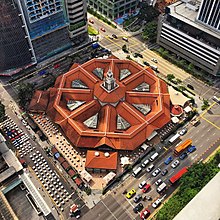Telok Ayer Market
Telok Ayer Market (Malaysian: Pasar Telok Ayer; Chinese: 直落 亚 逸 巴刹), now known as Lau Pa Sat (老 巴刹, "old market"), is a historic wet market in the Downtown Core in downtown Singapore . It originated from a fish market. It is currently a grocery center with other shops.
Surname
The name Telok Ayer means "water bay " in the Malaysian language. The site was actually on the seashore before the land reclamation project in Singapore began in 1879 and carried out near Telok Ayer Street until 1879 . The current name Lau Pa Sat means “old market” in Chinese. Lau (老) means old, while pa sat is the Hokkien pronunciation of the Persian word bazaar (market), which means pasar in Malay .
history
Telok Ayer Market was originally on the south bank of the Singapore River near the north end of Market Street , where a fish market was located. On November 4, 1822, as part of its general plan to redesign the town , Stamford directed Raffles to relocate the fish market to Telok Ayer. Construction began in 1823 at a location at the south end of Market Street on the banks of what was then Telok Ayer Basin, and the market opened that same year. However, the construction of wood and palm leaves proved problematic. The building was therefore rebuilt at the end of the 1830s. The new building was built on two octagonal rings of brick pillars, but it also required frequent repairs. In 1879, the market was demolished due to the land reclamation project in the Telok Ayer Basin and relocated to the newly reclaimed land on Collyer Quay. Construction began in 1890 and was completed in 1894.
In the early 1970s, plans were made to convert the area of the former Telok Ayer market into a business and financial district. A wet market that would be in the middle of office buildings was considered inappropriate. The market was redesigned and became a hall for street vendors. When the subway system was built in the mid-1980s , the former Telok Ayer market was dismantled piece by piece, and a few years later, after the construction work was completed, the historical structure was carefully reassembled. In 1989 the market was finally converted into a more upscale “festival market” and renamed “Lau Pa Sat”. After its last major renovation, Lau Pa Sat reopened in 2014.
On July 6, 1973, Telok Ayer Market was declared a National Monument .
description
The striking octagonal design already existed in the 1820s when the first concrete structures on the market were erected. It was remodeled around the turn of the century on land created by reclamation in the Telok Ayer Basin area, with a Victorian-style frame design being redesigned. It was the first market built by the Municipal Commission and one of the first structures in Asia to be made from pre-cast cast iron. The filigree cast and wrought iron parts were imported from Glasgow.
Web links
- Former Telok Ayer Market (now known as Lau Pa Sat) on roots.sg, the website of the National Heritage Board of Singapore (English)
Individual evidence
- ↑ a b Lau Pa Sat (Telok Ayer Market) , in: Wan Meng Hao, Heritage Places of Singapore , Marshall Cavendish International Asia Pte Ltd, 2011, page 24, online at: books.google.de / ... (temporarily not accessible)
- ↑ a b c Telok Ayer Market , in: Infopedia , Server of the National Library Board, Singapore Government, online (archived) at: web.archive.org /.../ infopedia.nl.sg / ...
- ↑ Wet Markets , publication by the National Heritage Board, a Singapore government agency, online at: nhb.gov.sg / ...
- ↑ a b Former Telok Ayer Market (now known as Lau Pa Sat) , website of the state National Heritage Board, online at: roots.sg / ...

